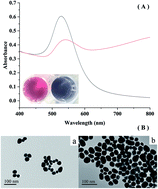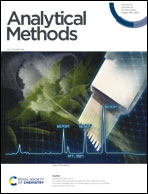Rapid determination of the pesticide ametryn based on a colorimetric aptasensor of gold nanoparticles†
Abstract
A new, simple colorimetric aptasensor based on the aggregation-induced color change of citrate-stabilized AuNPs was designed for the specific and sensitive determination of ametryn. Citrate-stabilized AuNPs with negative surface charges were synthesized via an easy one-pot reaction. Because of the electrostatic interaction between the three-nitrogen hybrid ring of ametryn and gold nanoparticles, the citrate-stabilized AuNPs easily undergo aggregation in the presence of ametryn. Thus, with a color change from wine red to gray, ametryn was visually detected by a colorimetric aptasensor. In addition, the detection result can also be measured quantitatively using a UV-vis spectrophotometer. The aptasensor has good selectivity and sensitivity to ametryn in the linear range of 0–80.0 μg L−1. According to the IUPAC criteria (3σ rule), the detection limit of ametryn is 0.15 μg L−1. Moreover, the aptasensor was successfully applied to the detection of ametryn in Yongding River from Zhaocun, Yizhuang Jingkai Sewage Treatment Plant and Yizhuang Nokia Factory water samples. The recovery reached 98.9–101.6%, 95.7–101.3% and 100.0–103.3%, respectively. The excellent performance of the colorimetric aptasensor in the detection of ametryn indicates its potential applications in the detection of ametryn in more complex environmental samples.



 Please wait while we load your content...
Please wait while we load your content...